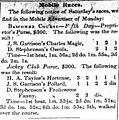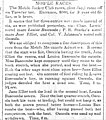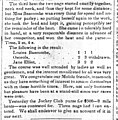
Metairie Cemetery is a historic cemetery in New Orleans, Louisiana, founded in 1872. The name has caused some people to mistakenly presume it is located in Metairie, Louisiana, but it is located within the New Orleans city limits on Metairie Road.

Fair Grounds Race Course, often known as New Orleans Fair Grounds, is a thoroughbred racetrack and racino in New Orleans, Louisiana. It is operated by Churchill Downs Louisiana Horseracing Company, LLC.
The Louisiana Derby is a Grade II American Thoroughbred horse race run annually at the Fair Grounds Race Course in New Orleans, Louisiana. Run in late March, the race is open to horses, age three, willing to race 1+3⁄16 miles on the dirt. It currently offers a purse of $1,000,000.

Jean-Bernard Xavier Philippe de Marigny de Mandeville (1785–1868), known as Bernard de Marigny, was a French-Creole American nobleman, playboy, planter, politician, duelist, writer, horse breeder, land developer, and President of the Louisiana State Senate between 1822 and 1823.

Sir Archy was an American Thoroughbred racehorse considered one of the best racehorses of his time and later one of the most important sires in American history. He was inducted into the National Museum of Racing and Hall of Fame in the inaugural class of 1955.

Skyscraper (1786–1807) was a British Thoroughbred racehorse. One of many notable offspring of the great Highflyer, Skyscraper is best known for winning The Derby of 1789. He competed until he was seven, when after losing two races he was retired to stud.

Meteora (1802–1821) was a British Thoroughbred racehorse and broodmare who won the classic Oaks Stakes at Epsom Downs Racecourse in 1805. In a racing career which began with her win in the Oaks on 31 May 1805 and lasted until July 1810 she ran thirty-six timeas and won twenty-four races. She defeated the Derby winner Cardinal Beaufort and the St Leger winner Staveley in match races and won many other important races of the era including the Stamford Gold Cup, the Oatlands Stakes (twice), the Audley End Stakes, the Somerset Stakes and the Brighton Gold Cup. Many of her defeats occurred when she was carrying large weights in handicap races.

Memnon was a British Thoroughbred racehorse and sire best known for winning the classic St Leger Stakes in 1825. In a racing career which lasted from 1824 until 1828 he ran fifteen times and won nine races. Bred and originally trained in Yorkshire, he was unbeaten in two races as two-year-old in 1824, including the Champagne Stakes and won the York version of the St Leger the following spring. In the St Leger at Doncaster in September 1825, he was successful as the heavily backed favourite in a record field of thirty runners. Memnon was later trained at Newmarket and recorded his most important subsequent victory when winning the Ascot Gold Cup as a five-year-old in 1827. After standing as a breeding stallion for five years in England with moderate results, he was sold and exported to Russia.
Staveley was a British Thoroughbred racehorse and sire best known for winning the classic St Leger Stakes in 1805. Bred in Yorkshire, he won seven of his nineteen races in a career which lasted from April 1805 until September 1807. As a three-year-old in 1805, he won his first three races, culminating with a victory at odds of 6/1 in the St Leger at Doncaster Racecourse. In the following season he was transferred to race at Newmarket, Suffolk, where he achieved mixed results, being beaten in most of his races but winning a match against The Derby winner Cardinal Beaufort. He won two further races in 1807 before being retired to stud in Yorkshire. He had no impact as a breeding stallion.
Sancho was a British Thoroughbred racehorse and sire best known for winning the classic St Leger Stakes in 1804. In a racing career which lasted from May 1804 until October 1806 he won eight of his twelve competitive races. Originally trained in Yorkshire, he was undefeated in four races as a three-year-old in 1805, culminating with his victory in the St Leger at Doncaster Racecourse. In the following season he was transferred to race in the south of England where he won a series of lucrative match races against some of the leading horses of the day. His five-year-old season proved disappointing and expensive for his owner as he was injured and beaten in both of his races. Sancho was retired from racing and showed considerable promise as a sire of winners in a brief stud career.
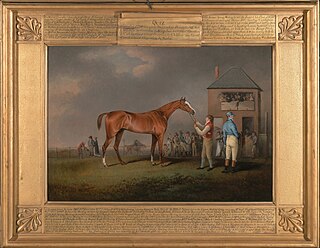
Quiz (1798–1826) was a British Thoroughbred racehorse and sire best known for winning the classic St Leger Stakes in 1801. Quiz was a durable, top-class performer, winning at least once a year in racing career which lasted seven seasons from August 1801 until April 1807. Apart from the St Leger he won many other important races including three Brocket Hall Gold Cups, two Oatlands Stakes at Newmarket Racecourse, a Great Subscription Purse at York, a King's Plate and the Jockey Club Plate. In all he won twenty-one times in thirty-six races for four different owners before being retired to stud, one of which was Mr Hallett Esq, where he proved to be a successful sire of winners.
Cockfighter (1796–1807) was a British Thoroughbred racehorse and sire best known for winning the classic St Leger Stakes in 1799. In a racing career which lasted from May 1799 until August 1802 he won ten of his eighteen races. Originally named Abraham Newland, he was renamed to reflect the sporting interests of Henry Tempest Vane who bought the horse in the summer of his three-year-old season. After bolting on his racecourse debut, Cockfighter was undefeated for more than two years, winning the St Leger, the Doncaster Cup, and three divisions of the Great Subscription Purse at York, and was regarded as the best horse in Northern England. He won the Craven Stakes in 1802, but was retired from racing after a run of defeats later that year. He had little opportunity to establish himself as a breeding stallion, dying in 1807 after four seasons at stud.
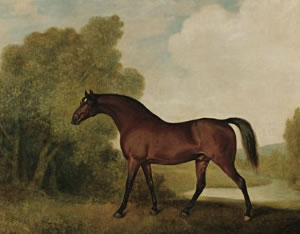
Ambrosio was a British Thoroughbred racehorse and sire best known for winning the classic St Leger Stakes in 1796. In a racing career which lasted from May 1796 until September 1799 he won fifteen of his twenty-three races. As a three-year-old he was based in Yorkshire, where he won his first three races before justifying his position as odds-on favourite for the St Leger, beating six opponents. In the next two years he competed mainly at Newmarket, where his victories three divisions of the Oatlands Stakes and the Jockey Club Plate. He returned to Yorkshire as a six-year-old to win a division of the Great Subscription Purse at York before being retired to stud. Ambrosio stood as a breeding stallion in Great Britain and Ireland, but had little success as a sire of winners.

Mango was a British Thoroughbred racehorse and sire best known for winning the classic St Leger Stakes in 1837. He won nine of his thirteen races in a racing career which lasted from October 1836 until October 1838. Mango was well-beaten in his only race as a two-year-old and finished unplaced in The Derby but won three races at Royal Ascot in June. In September he won an exceptionally rough race for the St Leger at Doncaster Racecourse and then won the Newmarket equivalent a month later. Mango won twice in the following year, but became increasingly temperamental and difficult to manage. He was retired to stud at the end of 1838 but proved a failure as a sire.

Henry Augustine Tayloe of Oakley Plantation, Essex County, Virginia, later Gallion, Canebrake, Alabama, was an American planter, slaveholder, horse breeder and racer, and land speculator in the 19th century.
The Washington Jockey Club was an American association in Washington, D.C. devoted to horse racing, founded in 1797. The club established its first racecourse four blocks from the Executive Mansion where it extended from 17th and 20th Streets and extending across Pennsylvania Avenue into Lafayette Park, what is now the site of Decatur House at H Street and Jackson Place, crossing Seventeenth Street and Pennsylvania Avenue to Twentieth Street, largely on the site of today’s Eisenhower Executive Office Building. The course was relocated in 1802 to the Holmead Farm two miles north of the Executive Mansion, to what is now Meridian Hill.
Leviathan (1823–1846) was a British Thoroughbred racehorse who won 16 of 21 starts before injury prompted his retirement. Imported into Tennessee in 1830, he was the leading sire in North America of 1837, 1838, 1839, 1843 and 1848, and also finished second five times. He was also an important broodmare sire, with modern descendants through the female line including Affirmed, Alydar and Dance Smartly.
The Eclipse Race Course was the third formal thoroughbred horse racing track in New Orleans, Louisiana, founded in 1837 by Captain Yelverton Oliver, who owned the famous thoroughbred Richard of York; a native Virginian, who organized The New Orleans Jockey Club.

The Mobile Jockey Club was an American sporting organization founded prior to 1836 in Mobile, Alabama.

The Louisiana Jockey Club was an American sporting association founded in 1837 with the completion of the Carrollton Race Course, in New Orleans, Louisiana. Today this is the only remaining Thoroughbred Race Course of the old-line tracks, the others which have closed are the Metairie Race Course, the Eclipse Race Course, and the Jackson Race Course; it exists today as the Fair Grounds Race Course, where races are still held-making it the 2nd oldest continuous racing track in operation in the United States, after the Freehold Raceway and before the Saratoga Race Course.



